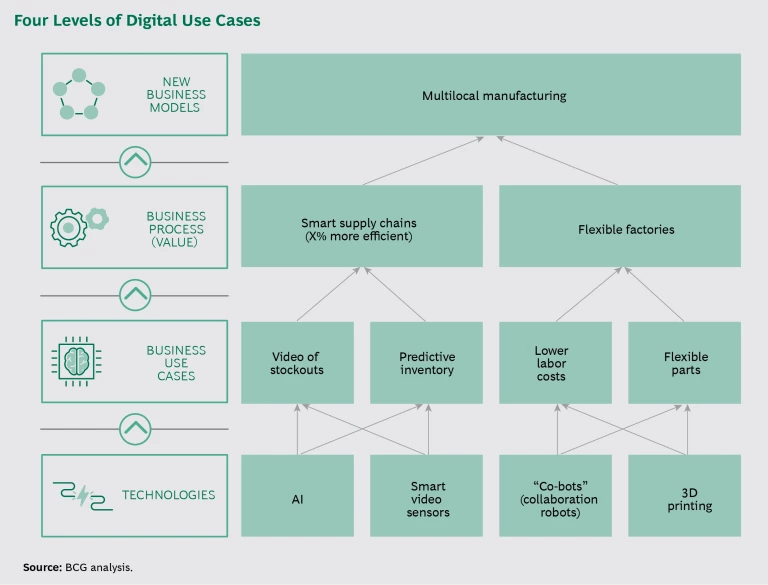Three questions that we hear more and more from our CEO clients with respect to digital:
- Am I moving fast enough?
- How can we bring a set of initiatives to industrial scale?
- What’s the endgame?
The business leaders we speak with daily understand well that the future will be shaped by digital technologies and their impact on every stage of companies’ value chains. At the same time, these leaders are frustrated by the lack of speed with which their companies (including their senior management teams) are embracing new technologies and ways of working, and often by the lack of tangible results from big investments in systems and technology—the evidence that their own bets on new tech are paying off.
At its core, a digital transformation is a reset, grounded in new technologies, of a company’s market strategy, offerings, and ways of working. The concept of a business journey has become something of a cliché. Still, digital transformations are indeed journeys; they take two to three years, and it’s not a simple trip. Digital transformations must be bold and ambitious, yet thoroughly pragmatic at the same time.
To succeed, a digital transformation must result in a company that interacts in new ways with its customers, uses technology to reimagine business processes, and embeds new capabilities (both human and machine) into the organization. Since both digital technologies and the advances they enable are pushing forward at a relentless pace, the transformation must produce a highly adaptive organization—one with the skills and agility needed to keep pace with continuous digital change in the decade to come.
Based on our experience with hundreds of leaders confronting digital change, and the hundreds of transformations that resulted (some very successful and some less so), here’s a common-sense approach to how CEOs and their top management teams should approach digital transformation.
The Digital Imperative
Let’s start with a few facts—the reason companies need to change in the first place. Digital hype has matured into market-shaping business realities. Some technologies have become facts of everyday life: e-commerce, social media, and mobile, for example. Others, such as artificial intelligence (AI), the Internet of Things (IoT), and blockchain, are rapidly marching toward market maturity. Woven together, the resulting business possibilities are game-changing in many sectors. Leading companies are introducing radical innovations in customer engagement, supply chain management, automated and flexible operations, and the use of data to drive growth. The results are no longer jaw-dropping tech demonstrations (which, more often than not, were also vaporware); we’re now seeing dramatic, demonstrable bottom-line impact. Some examples:
- Increases of 6% to 10% in revenue growth rates from personalization
- Expansion of operating margins by up to 25% by digitizing manufacturing functions
- Two to four times faster speed to market from agile ways of working
- Reductions in headcount of 50% to 75% in functions in which activities can be automated
- Cuts in service costs of 70% with smart maintenance applications
Digital is affecting every link in the corporate value chain. The changes taking place are reshaping income statements and balance sheets and fundamentally altering competitive positions. Examples are all around us. Starbucks is developing one-on-one customer relationships at scale. It is individualizing its brand by giving customers their own personalized experience, encompassing in-store visits, digital interactions, and even, potentially, the products offered. (See “ Profiting from Personalization ,” BCG article, May 2017.) Caterpillar offers a range of digital services that help customers boost the productivity and efficiency of their construction equipment, no matter where it is located around the world. Appliance manufacturer Arçelik, a subsidiary of Koç Holding (the largest conglomerate in Turkey), established a shared creative platform to encourage design-focused thinking, and it accelerated its activities to develop communication protocols, cloud security, data analytics, robotics, and AI related to digitalization and IoT. Finally, it created Atölye 4.0, a digital factory that utilizes advanced automation tools, AI, digital twins, image processing, and mobile and collaborative robots. Brazilian food producer BRF is piloting blockchain technology to provide full traceability and transparency for products moving through its supply and delivery chains. AirAsia has embedded data usage and technology throughout its operations to create the world’s lowest-cost airline.
At its core, a digital transformation is a reset, grounded in new technologies, of a company’s market strategy, offerings, and ways of working.
More change is coming fast. Research conducted by BCG and MIT Sloan Management Review found that more than three-quarters of business executives expect AI to create competitive advantage or new lines of business for their companies (even though less than 40% of companies now have an AI strategy in place). The economic impacts of these developments are not incremental. Digital has made the transition from promise to reality, and this drives the imperative to transform. The players that capture the benefits first will gain significant competitive advantage.
Focus on Business Use Cases
Even with a strong desire to act boldly, companies can find it challenging to gain a pragmatic understanding of what technologies such as AI or blockchain or IoT can do for them. Not only are the technologies complex, they are continually evolving.
Business leaders need a basic understanding of the technologies at work. More important, they need to focus on validating what the technologies can do for their companies now and in the near future. They must identify the areas in which technologies can be applied to generate new products or services or to fundamentally change and improve processes and operations. (See the exhibit.) Most of us will never fully understand how blockchain technology works, for example. But we can readily grasp the value of low-cost and indisputable smart contracts, permanent inventory records, automatic tracking of raw materials through the supply chain, and similar capabilities that blockchain enables.
This is one reason that BCG is building a library of digital “use cases” across all sectors and all parts of the value chain. We assess them continuously for their stage of development and the tangible value they deliver today in real businesses, even as we add new examples. CEOs should demand clarity within their own organizations on the digital use cases that can have the biggest impacts on their businesses.
The Essential Digital Agenda
Digital has the potential to change businesses end to end—from customer engagement and product design to manufacturing to marketing and distribution. Companies that want to take full advantage of digital’s power need to ground their future strategy, competitive advantage, customer engagement models, operations, and organizations in the new realities of what digital allows. (See Designing Digital Organizations , BCG Focus, December 2016.) This essential digital agenda—the transformation journey—involves all core components of the company.
Creating a Lighthouse Strategy to Show the Way
Companies need to reset their strategies for a digital world. They require a strategic view of where they want to go—and how to adapt their business strategy and competitive advantage accordingly. This “lighthouse” view will not be static; given the dynamism of today’s world, it will evolve and need to be more flexible than previous plans. Still, the lighthouse view is critical to motivating and aligning the organization, and even more, to ensuring that the digital efforts deliver real and sustainable value.
Adapting Products and Services and the Customer Model
Companies must develop, together with the strategic view, an in-depth picture of how they want their customer experiences and engagement model to evolve. In both B2C and B2B, customers trained by the likes of Amazon and Netflix have come to expect improved engagement and experiences. And they are increasingly frustrated and unhappy when that’s not what they get. Data and analytics allow for much deeper customer insights and new mobile and digital engagement models. Companies must understand customer journeys, their points of pain and friction, and then rapidly evolve and enhance the customer engagement model.
Over the next five years in retail, health care, and financial services, personalization and data-driven marketing could push a revenue shift of some $800 billion to the 15% of companies that get it right.
We find that the most sophisticated companies are launching a portfolio of digital product and service innovations. One goal, of course, is to meet market needs. For example, personalization at scale can now be applied at the level of individualized relationships, prices, and offers. Over the next five years in three sectors alone—retail, health care, and financial services—we expect personalization and data-driven marketing to push a revenue shift of some $800 billion to the 15% of companies that get it right. Just as important, innovations such as these demonstrate companies’ willingness to change and their ability to do so.
Reimagining Business Processes and Operations
Automated processes and digital tools can make all areas of a company faster, stronger, and more flexible. Companies need to learn how to build and operate interactive people–machine processes, especially as AI and IoT enter the mainstream. These are fundamentally different models than traditional shared services or outsourcing. Digital is allowing service operations, traditionally built at the local level, to function at global scale. At the same time, manufacturing automation is reshaping production economics so that traditional cost considerations, such as labor, no longer dictate factory location.
Data is the essential commodity in a digital world. The ability to collect, process, and gain business insights from all kinds of data from myriad sources will separate winners from losers. Companies need to pilot and scale up lighthouse use cases that demonstrate tangible business value, then build a data and technology stack that will enable the organization to capture value more broadly from data and analytics. (The way to start, however, is not with a technology program; see below.)
Building a Digital Organization
The critical enabling factor for all of the above is a transformation of the way the company works. Digital organizations are built around speed, agility, adaptation, and testing and learning. Digital requires new capabilities, and most change projects will need multifunctional teams with a broader range of skill sets (including analytics, user design, and technical expertise) than companies are used to. We find that the most successful companies adopt some aspects of the agile methodology at scale, which can lead to impressive gains in productivity, employee engagement, quality, and, most significantly, speed. (See “ Five Secrets to Scaling Up Agile ,” BCG article, February 2016, and “ Taking Agile Way Beyond Software ,” BCG article, July 2017.)
Jump-Starting a Self-Funded Transformation
Neither managers nor investors are patient or particularly trusting when it comes to change. Both need to see demonstrable results early in the process to be convinced that the changes are real and that the potential benefits outweigh the risk. Digital transformations have the biggest impact—and the best chance for long-term success—when they show early results and are essentially self-funded within the first year or two.
There are a few key mistakes to avoid. Don’t tie up the organization in a lengthy study or strategy review. It’s also a mistake to start by trying to build the right tech platform or data warehouse. Instead, companies should follow a four-step model designed to jump-start the transformation and build early momentum with managers and investors alike.
The first step is to set forth the lighthouse vision of where you are going and what you expect to accomplish along the way so that investors, managers, and employees can see the big picture. Then identify the key digital use cases—the “internal unicorns”—that can have rapid impact and drive value in the near term.
Don’t tie up the organization in a lengthy study or strategy review. It’s also a mistake to start by trying to build the right tech platform or data warehouse.
Second, create cross-functional, agile teams to move these initiatives forward. Support them with adequate financial and organizational resources. Don’t be cheap; these should be significant bets. The goal is to generate rapid results in order to fund the transformation and build momentum.
Great initial use cases often include the following:
- Moving from a product- or service-driven strategy to one built around customer journeys, with the goal of enhancing the customer experience and generating new revenues or lowering operating costs
- Digital innovation sprints to identify new businesses or services that the company can deliver at scale
- Analytic sprints to drive new profit streams on the order of tens of millions of dollars from data-centric opportunities such as personalization, redesigned pricing, reduced churn, or supply chain optimization
- Industry 4.0 pilots in key facilities that can be rapidly scaled across other parts of the company
- Digital shared functions that leverage new technologies end to end in order to improve quality of service to the business and reduce costs
- Agile pilots that can rapidly redesign internal functions and be scaled across the company
Whichever initiatives are chosen, the ambition should be bold. They must be backed by visible senior commitment in order to bring along the full organization. The overarching near-term goal should be quick wins that improve the customer experience, drive revenue, or reduce cost—all measurable and reportable results that will generate momentum and show that management has a viable plan and is serious about implementation.
Organizations need to pursue over time both foundational change and waves of new use initiatives that drive visible value and customer excitement.
As momentum builds, the third step is to determine your model for scaling change and transforming the full organization. At a minimum, the foundational changes will need to include constructing a data capability (including compliance), rethinking the technology stack, ensuring cybersecurity, and addressing the organization, talent, and ways of working. Certain industries, such as financial services and health care, will need to build in regulatory considerations. We find that two change models are working well. One— which we call build-operate-transfer (BOT) —involves setting up a technology center to pilot high-potential use cases and then scaling them through the organization. The other, Agile @ Scale, involves rolling out the agile methodology across the full organization together with more structural changes in organization design.
The fourth step is to be persistent. Organizations need to pursue over time both foundational change and waves of new use case initiatives that drive visible value and customer excitement.
The Tests of Success
Digital and accelerated change will be with us for years to come. This first digital transformation will not be the endgame or determine the longer-term success of your company. But it is a critical step that will set a course and enable more and faster change down the road. In the future, speed will be as or more important than scale, and every company needs to build the capabilities that will let it adapt to changing circumstances much more quickly and flexibly.
CEOs should give themselves three tests of success over the first 18 to 36 months:
- Have we radically enhanced our products, services, and customer engagement model?
- Have we harnessed digital to drive greater value in the operations of the company?
- Is our organization now digitally capable and able to adapt at the speed required for the coming years of further change?
If they can answer yes to these questions as the initial transformation period reaches its conclusion, they will have answered the three questions posed at the outset—and set a highly pragmatic foundation for a digital future.









